torque TOYOTA HIGHLANDER 2022 User Guide
[x] Cancel search | Manufacturer: TOYOTA, Model Year: 2022, Model line: HIGHLANDER, Model: TOYOTA HIGHLANDER 2022Pages: 568, PDF Size: 13.73 MB
Page 452 of 568
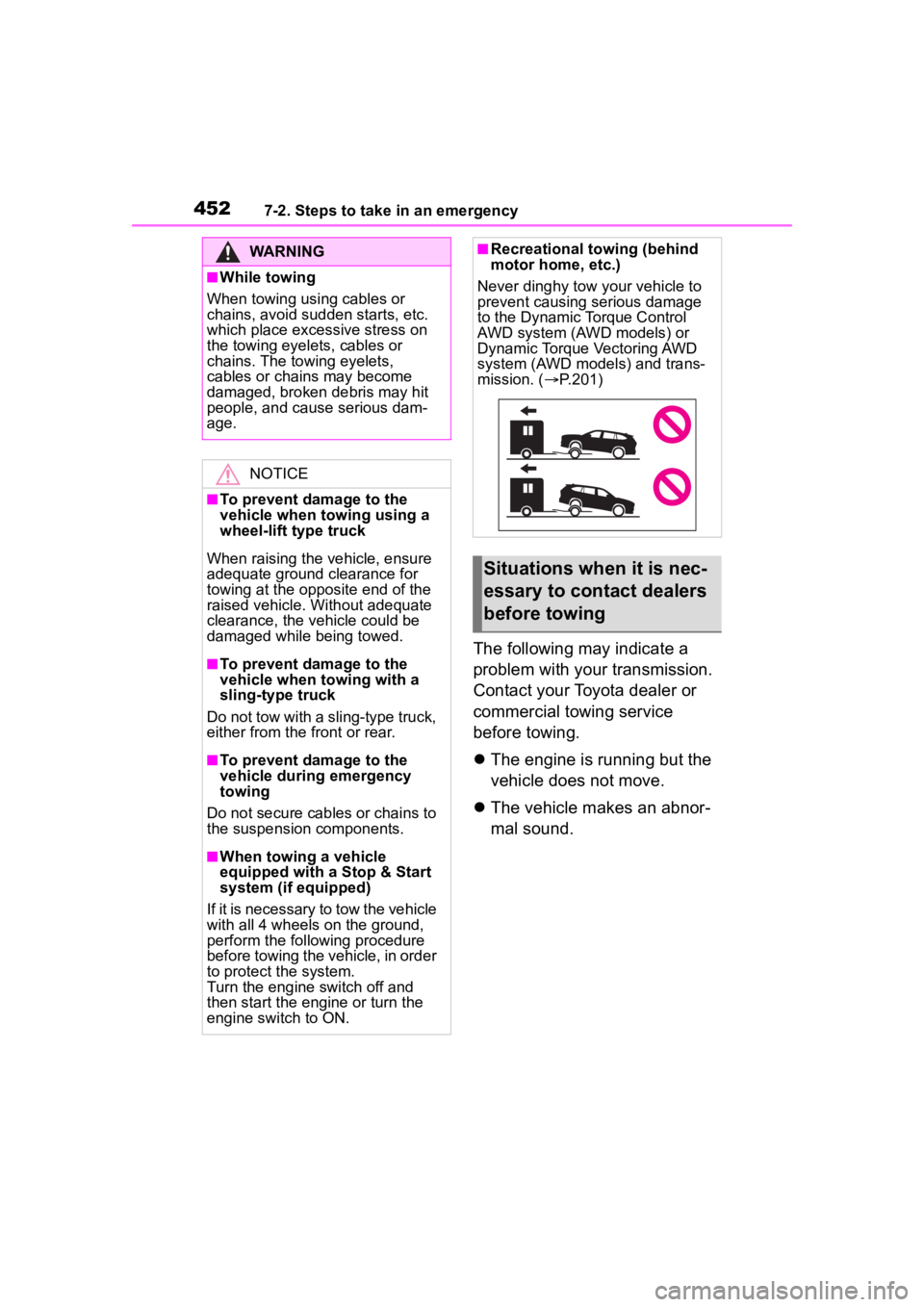
4527-2. Steps to take in an emergency
The following may indicate a
problem with your transmission.
Contact your Toyota dealer or
commercial towing service
before towing.
The engine is running but the
vehicle does not move.
The vehicle makes an abnor-
mal sound.
WARNING
■While towing
When towing using cables or
chains, avoid sudden starts, etc.
which place excessive stress on
the towing eyelets, cables or
chains. The towing eyelets,
cables or chains may become
damaged, broken debris may hit
people, and cause serious dam-
age.
NOTICE
■To prevent damage to the
vehicle when towing using a
wheel-lift type truck
When raising the vehicle, ensure
adequate ground clearance for
towing at the opposite end of the
raised vehicle. Without adequate
clearance, the vehicle could be
damaged while being towed.
■To prevent damage to the
vehicle when towing with a
sling-type truck
Do not tow with a sling-type truck,
either from the front or rear.
■To prevent damage to the
vehicle during emergency
towing
Do not secure cables or chains to
the suspension components.
■When towing a vehicle
equipped with a Stop & Start
system (if equipped)
If it is necessary to tow the vehicle
with all 4 wheels on the ground,
perform the following procedure
before towing the vehicle, in order
to protect t he system.
Turn the engine switch off and
then start the engine or turn the
engine switch to ON.
■Recreational towing (behind
motor home, etc.)
Never dinghy tow your vehicle to
prevent causing serious damage
to the Dynamic Torque Control
AWD system (AWD models) or
Dynamic Torque Vectoring AWD
system (AWD models) and trans-
mission. ( P.201)
Situations when it is nec-
essary to contact dealers
before towing
Page 472 of 568
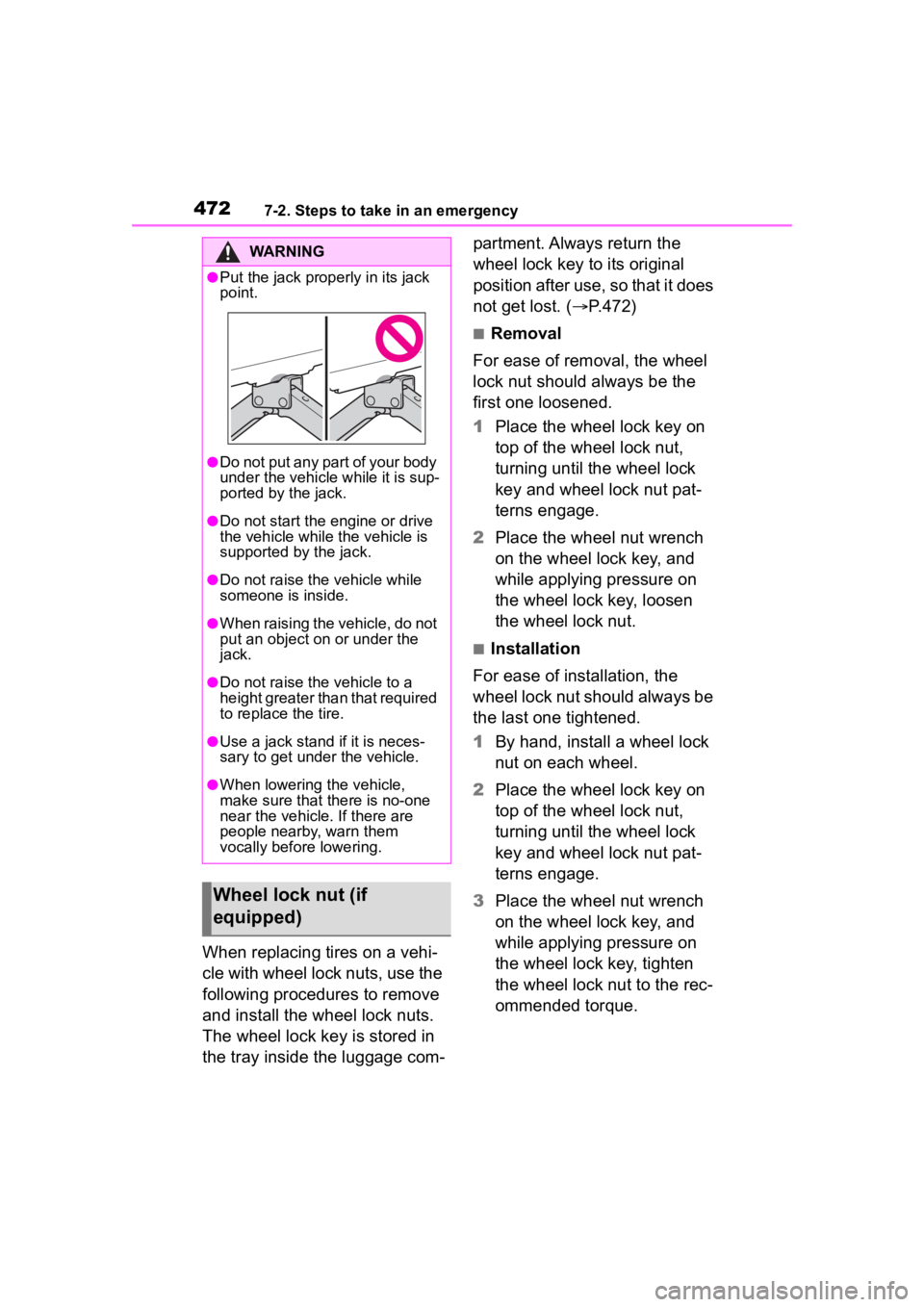
4727-2. Steps to take in an emergency
When replacing tires on a vehi-
cle with wheel lock nuts, use the
following procedures to remove
and install the wheel lock nuts.
The wheel lock key is stored in
the tray inside the luggage com- partment. Always return the
wheel lock key to its original
position after use, so that it does
not get lost. (
P.472)
■Removal
For ease of removal, the wheel
lock nut should always be the
first one loosened.
1 Place the wheel lock key on
top of the wheel lock nut,
turning until the wheel lock
key and wheel lock nut pat-
terns engage.
2 Place the wheel nut wrench
on the wheel lock key, and
while applying pressure on
the wheel lock key, loosen
the wheel lock nut.
■Installation
For ease of installation, the
wheel lock nut should always be
the last one tightened.
1 By hand, install a wheel lock
nut on each wheel.
2 Place the wheel lock key on
top of the wheel lock nut,
turning until the wheel lock
key and wheel lock nut pat-
terns engage.
3 Place the wheel nut wrench
on the wheel lock key, and
while applying pressure on
the wheel lock key, tighten
the wheel lock nut to the rec-
ommended torque.
WARNING
●Put the jack prope rly in its jack
point.
●Do not put any part of your body
under the vehicle while it is sup-
ported by the jack.
●Do not start the engine or drive
the vehicle while the vehicle is
supported by the jack.
●Do not raise the vehicle while
someone is inside.
●When raising the vehicle, do not
put an object on or under the
jack.
●Do not raise the vehicle to a
height greater than that required
to replace the tire.
●Use a jack stand if it is neces-
sary to get under the vehicle.
●When lowering the vehicle,
make sure that there is no-one
near the vehicle. If there are
people nearby, warn them
vocally before lowering.
Wheel lock nut (if
equipped)
Page 478 of 568
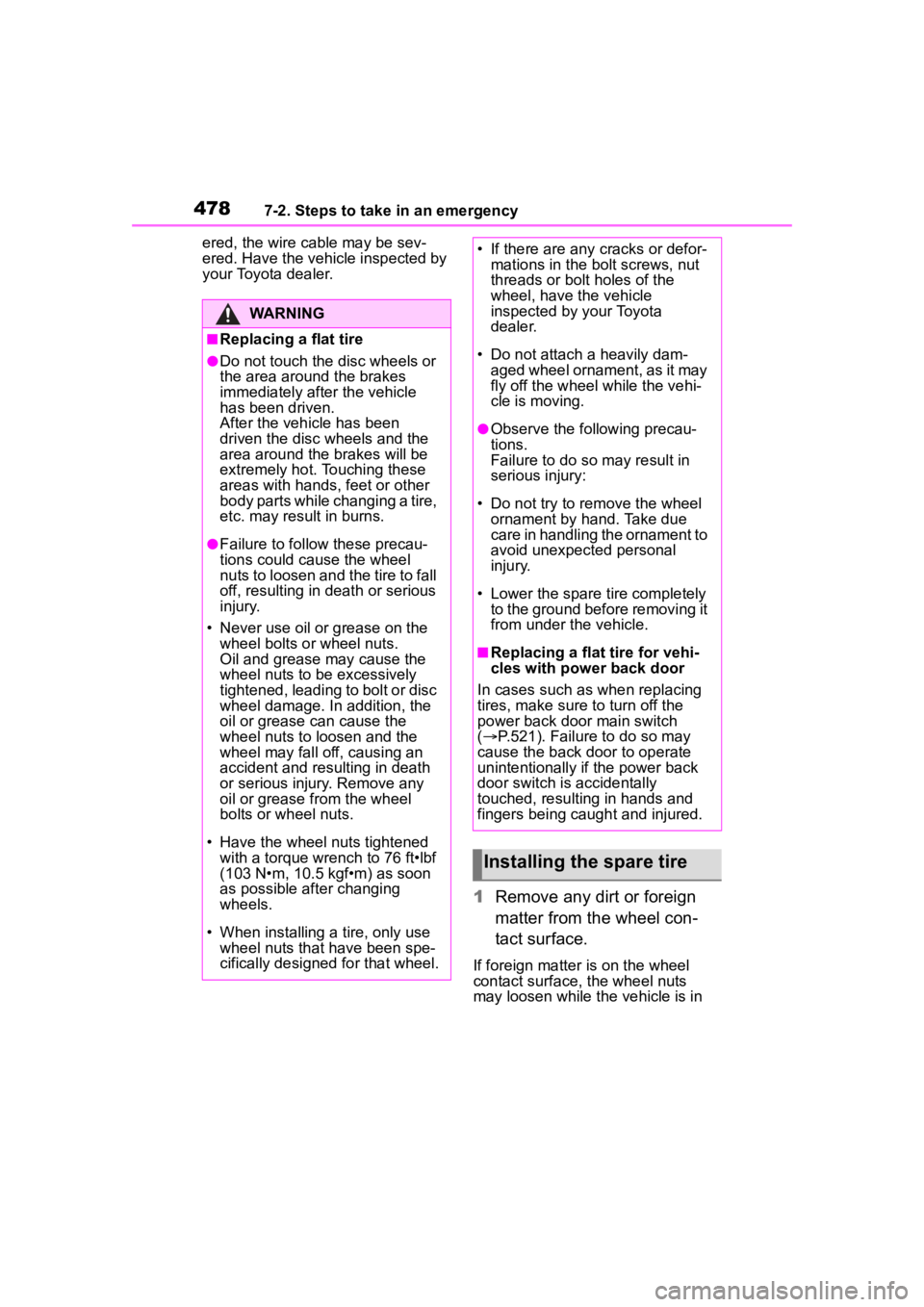
4787-2. Steps to take in an emergency
ered, the wire cable may be sev-
ered. Have the vehicle inspected by
your Toyota dealer.
1Remove any dirt or foreign
matter from the wheel con-
tact surface.
If foreign matter is on the wheel
contact surface, the wheel nuts
may loosen while the vehicle is in
WARNING
■Replacing a flat tire
●Do not touch the disc wheels or
the area around the brakes
immediately after the vehicle
has been driven.
After the vehicle has been
driven the disc wheels and the
area around the brakes will be
extremely hot. Touching these
areas with hands , feet or other
body parts while changing a tire,
etc. may result in burns.
●Failure to follow these precau-
tions could cause the wheel
nuts to loosen and the tire to fall
off, resulting in death or serious
injury.
• Never use oil or grease on the wheel bolts or wheel nuts.
Oil and grease may cause the
wheel nuts to be excessively
tightened, leading to bolt or disc
wheel damage. In addition, the
oil or grease can cause the
wheel nuts to loosen and the
wheel may fall off, causing an
accident and resulting in death
or serious injury. Remove any
oil or grease from the wheel
bolts or wheel nuts.
• Have the wheel nuts tightened with a torque wrench to 76 ft•lbf
(103 N•m, 10.5 kgf•m) as soon
as possible after changing
wheels.
• When installing a tire, only use wheel nuts that have been spe-
cifically designed for that wheel.
• If there are any cracks or defor- mations in the bolt screws, nut
threads or bolt holes of the
wheel, have the vehicle
inspected by your Toyota
dealer.
• Do not attach a heavily dam- aged wheel ornament, as it may
fly off the wheel while the vehi-
cle is moving.
●Observe the fo llowing precau-
tions.
Failure to do so may result in
serious injury:
• Do not try to remove the wheel ornament by hand. Take due
care in handling the ornament to
avoid unexpected personal
injury.
• Lower the spare tire completely to the ground before removing it
from under the vehicle.
■Replacing a flat tire for vehi-
cles with power back door
In cases such as when replacing
tires, make sure to turn off the
power back door main switch
( P.521). Failure to do so may
cause the back d oor to operate
unintentionally if the power back
door switch is accidentally
touched, resulti ng in hands and
fingers being caught and injured.
Installing the spare tire
Page 479 of 568
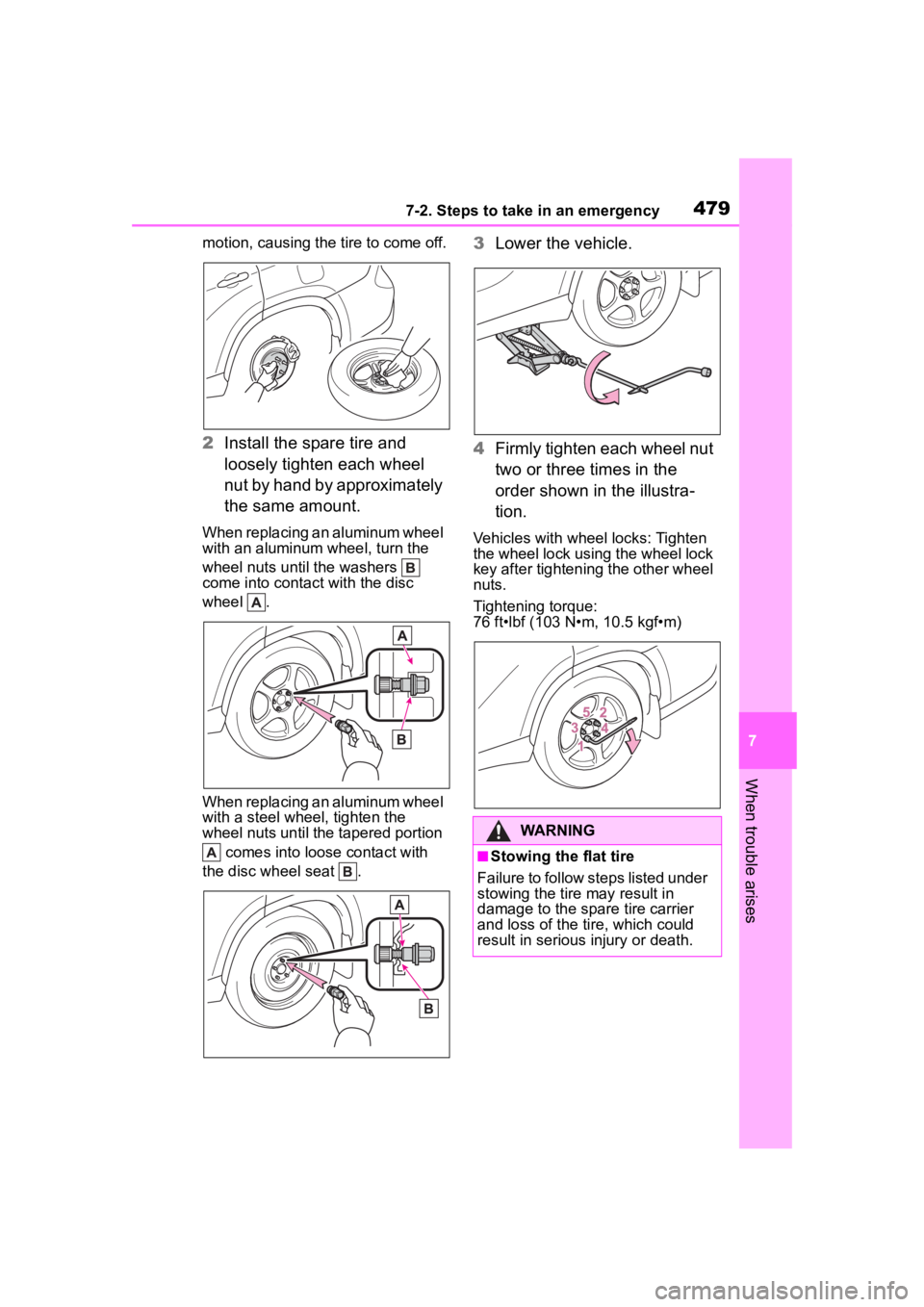
4797-2. Steps to take in an emergency
7
When trouble arises
motion, causing the tire to come off.
2Install the spare tire and
loosely tighten each wheel
nut by hand by approximately
the same amount.
When replacing an aluminum wheel
with an aluminum wheel, turn the
wheel nuts until the washers
come into contact with the disc
wheel .
When replacing an aluminum wheel
with a steel wheel, tighten the
wheel nuts until the tapered portion
comes into loose contact with
the disc wheel seat .
3 Lower the vehicle.
4 Firmly tighten each wheel nut
two or three times in the
order shown in the illustra-
tion.
Vehicles with wheel locks: Tighten
the wheel lock using the wheel lock
key after tightening the other wheel
nuts.
Tightening torque:
76 ft•lbf (103 N•m, 10.5 kgf•m)
WARNING
■Stowing the flat tire
Failure to follow steps listed under
stowing the tire may result in
damage to the spare tire carrier
and loss of the tire, which could
result in serious injury or death.
Page 505 of 568
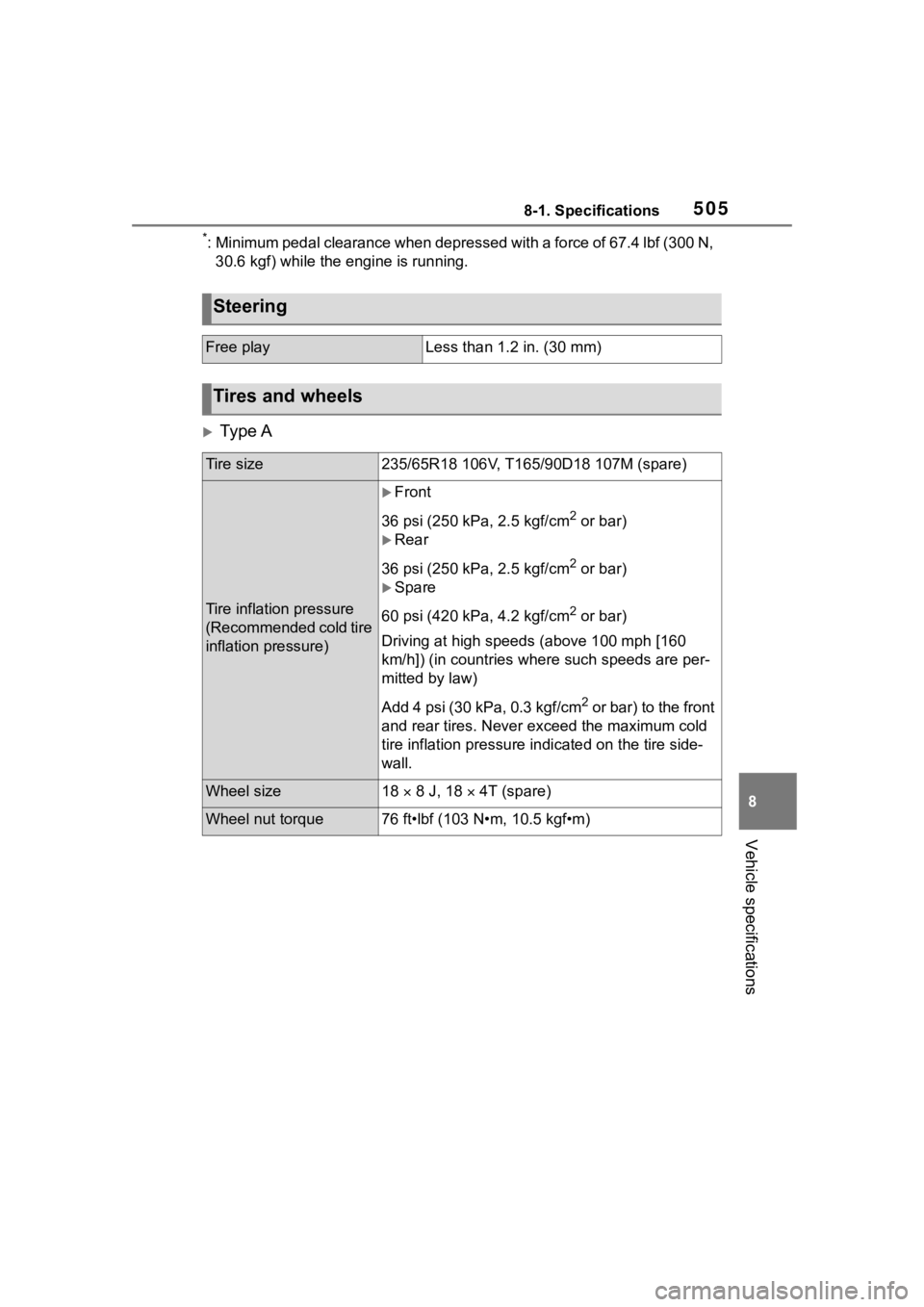
5058-1. Specifications
8
Vehicle specifications
*: Minimum pedal clearance when depressed with a force of 67.4 lbf (300 N, 30.6 kgf) while the engine is running.
Ty p e A
Steering
Free playLess than 1.2 in. (30 mm)
Tires and wheels
Tire size235/65R18 106V, T165/90D18 107M (spare)
Tire inflation pressure
(Recommended cold tire
inflation pressure)
Front
36 psi (250 kPa, 2.5 kgf/cm
2 or bar)
Rear
36 psi (250 kPa, 2.5 kgf/cm
2 or bar)
Spare
60 psi (420 kPa, 4.2 kgf/cm
2 or bar)
Driving at high speeds (above 100 mph [160
km/h]) (in countries wher e such speeds are per-
mitted by law)
Add 4 psi (30 kPa, 0.3 kgf/cm
2 or bar) to the front
and rear tires. Never exceed the maximum cold
tire inflation pressure in dicated on the tire side-
wall.
Wheel size18 8 J, 18 4T (spare)
Wheel nut torque76 ft•lbf (103 N•m, 10.5 kgf•m)
Page 506 of 568
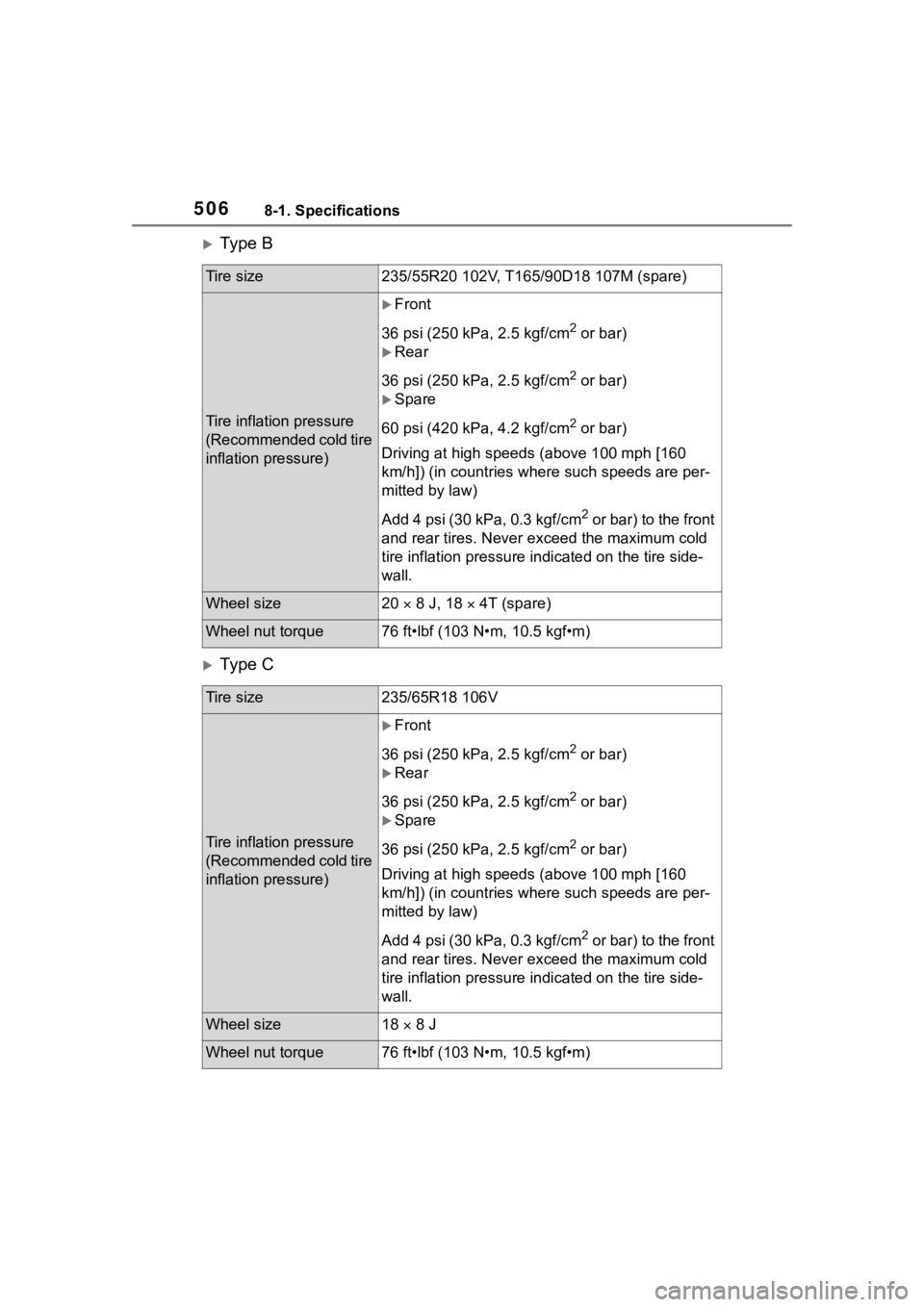
5068-1. Specifications
Ty p e B
Ty p e C
Tire size235/55R20 102V, T165/90D18 107M (spare)
Tire inflation pressure
(Recommended cold tire
inflation pressure)
Front
36 psi (250 kPa, 2.5 kgf/cm
2 or bar)
Rear
36 psi (250 kPa, 2.5 kgf/cm
2 or bar)
Spare
60 psi (420 kPa, 4.2 kgf/cm
2 or bar)
Driving at high speeds (above 100 mph [160
km/h]) (in countries wher e such speeds are per-
mitted by law)
Add 4 psi (30 kPa, 0.3 kgf/cm
2 or bar) to the front
and rear tires. Never exceed the maximum cold
tire inflation pressure in dicated on the tire side-
wall.
Wheel size20 8 J, 18 4T (spare)
Wheel nut torque76 ft•lbf (103 N•m, 10.5 kgf•m)
Tire size235/65R18 106V
Tire inflation pressure
(Recommended cold tire
inflation pressure)
Front
36 psi (250 kPa, 2.5 kgf/cm
2 or bar)
Rear
36 psi (250 kPa, 2.5 kgf/cm
2 or bar)
Spare
36 psi (250 kPa, 2.5 kgf/cm
2 or bar)
Driving at high speeds (above 100 mph [160
km/h]) (in countries wher e such speeds are per-
mitted by law)
Add 4 psi (30 kPa, 0.3 kgf/cm
2 or bar) to the front
and rear tires. Never exceed the maximum cold
tire inflation pressure in dicated on the tire side-
wall.
Wheel size18 8 J
Wheel nut torque76 ft•lbf (103 N•m, 10.5 kgf•m)
Page 507 of 568
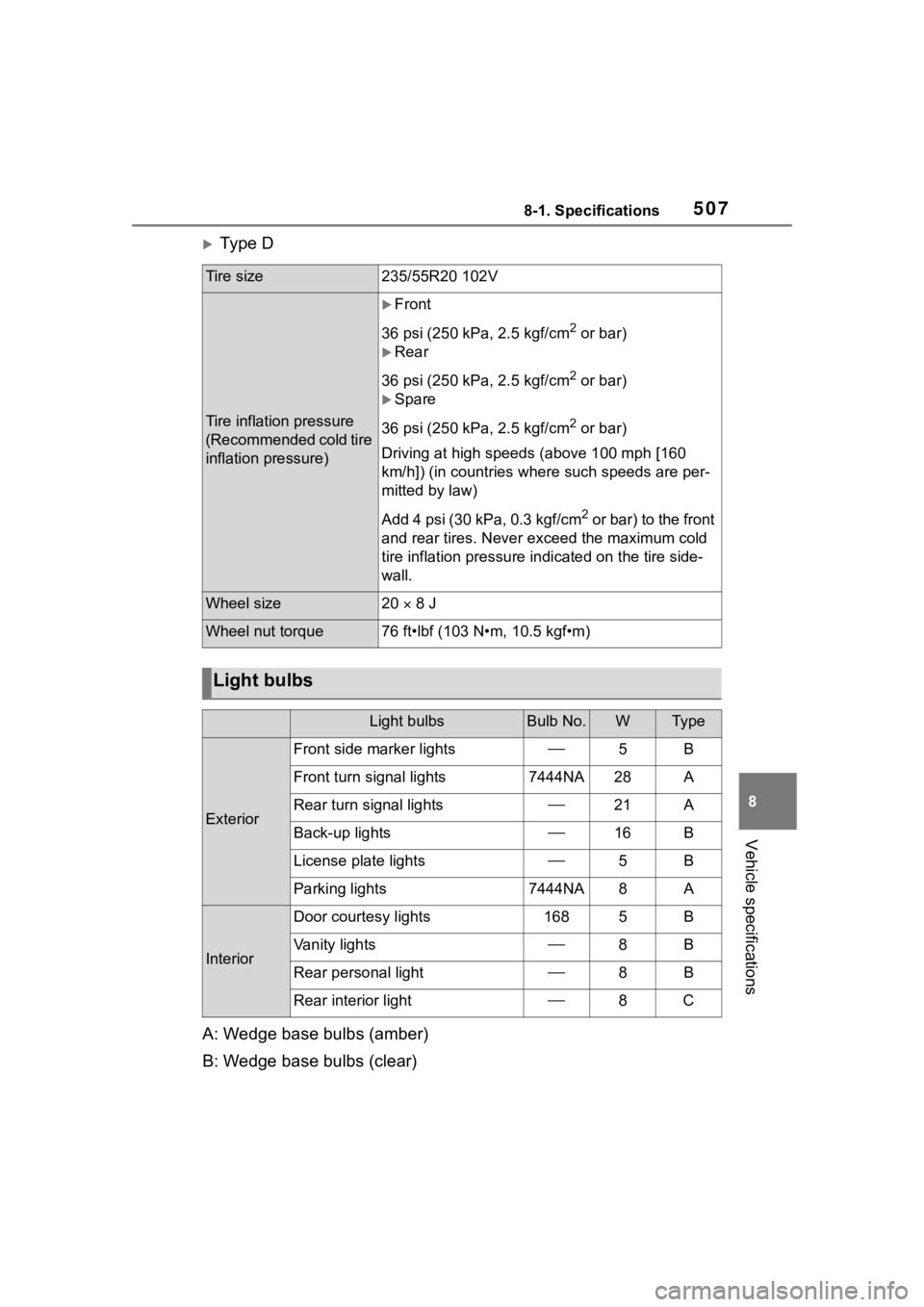
5078-1. Specifications
8
Vehicle specifications
Ty p e D
A: Wedge base bulbs (amber)
B: Wedge base bulbs (clear)
Tire size235/55R20 102V
Tire inflation pressure
(Recommended cold tire
inflation pressure)
Front
36 psi (250 kPa, 2.5 kgf/cm
2 or bar)
Rear
36 psi (250 kPa, 2.5 kgf/cm
2 or bar)
Spare
36 psi (250 kPa, 2.5 kgf/cm
2 or bar)
Driving at high speeds (above 100 mph [160
km/h]) (in countries wher e such speeds are per-
mitted by law)
Add 4 psi (30 kPa, 0.3 kgf/cm
2 or bar) to the front
and rear tires. Never exceed the maximum cold
tire inflation pressure in dicated on the tire side-
wall.
Wheel size20 8 J
Wheel nut torque76 ft•lbf (103 N•m, 10.5 kgf•m)
Light bulbs
Light bulbsBulb No.WTy p e
Exterior
Front side marker lights5B
Front turn signal lights7444NA28A
Rear turn signal lights21A
Back-up lights16B
License plate lights5B
Parking lights7444NA8A
Interior
Door courtesy lights1685B
Vanity lights8B
Rear personal light8B
Rear interior light8C
Page 553 of 568

553Alphabetical Index
Clock ................................... 81, 84
Coat hooks .............................. 382
Condenser .............................. 414
Console box ............................ 365
Consumption screen.............. 108
Conversation mirror ............... 384
Cooling system ...................... 413Engine overheating .............. 494
Cruise control Dynamic radar cruise control with full-speed range .......... 257
Cup holders ............................ 366
Current fuel consumption . 86, 94
Curtain shield airbags ............. 34
Customizable features ........... 521
D
Daytime running light system216 Replacing light bulbs ............ 439
Defogger Outside rear view mirrors ... 335, 341, 345
Rear window ........ 335, 341, 345
Windshield............ 335, 341, 344
Differential Rear differential oil ............... 504
Digital Rearview Mirror .......... 155
Dimension ............................... 500
Dinghy towing ........................ 201
Display Dynamic radar cruise control with full-speed range .......... 257
Head-up display ................... 103
Intuitive parking assist .......... 284
LTA (Lane Tracing Assist) ..... 252
Multi-information display .. 84, 93
RCTA .................................... 293
Toyota Multi-operation touch 332
Warning message ................ 467
Distance until next engine oil change..................................... 83
Do-it-yourself maintenance ... 401 Door courtesy lights...............361
Door lock
Back door .............................121
Side doors ............................ 117
Smart key system .................133
Wireless remote control........ 115
Doors Automatic door locking and unlocking system ................120
Back door .............................121
Door glasses ........................167
Door lock ..............................121
Open door warning buzzer . 118, 120
Outside rear view mirrors .....165
Rear door child-protectors ....120
Downhill assist control system ...............................................316
Drive distance .....................88, 97
Drive information .. ..............88, 97
Driver’s seat position memory Driving position memory .......147
Memory recall function .........149
Drive-start control ..................180
Driving Break-in tips .........................180
Correct driving posture ...........25
Driving mode select switch ... 311
Procedures ...........................179
Winter drive tips....................324
Driving information display85, 94
Driving mode select switch ... 311
Driving position memory .......147 Memory recall function .........149
Driving range ................86, 94, 95
Driving support system informa- tion display........................87, 97
Dynamic radar cruise control with full-speed range............257Warning message.................267
Dynamic Torque Control AWD system ...................................319
Page 554 of 568

554Alphabetical Index
Dynamic Torque Vectoring AWD system ................................... 319
E
Eco drive mode ...................... 311
Eco Driving Indicator . 86, 95, 106
Eco Driving Indicator Light86, 95
EDR (Event data recorder)......... 8
Elapsed time ....................... 88, 97
Electric Power Steering (EPS) ............................................... 318Warning light ........................ 458
Electronic key ......................... 114 Battery-saving function......... 134
If the electronic key does not operate properly ................. 488
Replacing the battery ........... 434
Electronic roof sunshade Jam protection function ........ 174
Operation ............................. 173
Emergency flashers ............... 448
Emergency, in case of If a warning buzzer sounds .. 456
If a warning light turns on ..... 456
If a warning message is dis-played................................. 467
If the battery is discharged ... 490
If the electronic key does not operate properly ................. 488
If the engin e will not start ..... 485
If the fuel filler door cannot be opened ............................... 487
If the vehicle is submerged or water on the road is rising .. 449
If you have a flat tire ............. 471
If you lose your keys ............ 486
If you think something is wrong ........................................... 454
If your vehicle becomes stuck ........................................... 496
If your vehicle has to be stopped in an emergency................. 448 If your vehicle needs to be towed
...........................................451
If your vehicle ove rheats ......494
Engine ACCESSORY mode . ............204
Compartment........................410
Engine switch .......................202
Fuel pump shut off system ...455
Hood .....................................408
How to start the engine ........202
Identification number ............501
If the engine will not start......485
If your vehicle has to be stopped in an emergency .................448
Ignition switch (engine switch) ...........................................202
Overheating ..........................494
Tachometer.............................81
Engine coolant Capacity ...............................503
Checking ..............................413
Preparing and checking before winter ..................................324
Engine coolant temperature gauge .......................................81
Engine immobilizer system .....71
Engine oil Capacity ...............................502
Checking ..............................410
Preparing and checking before winter ..................................324
Warning light.........................457
Engine oil maintenance data .412
Engine switch .........................202 Auto power off fun ction .........205
Changing the engine switch modes.................................204
If your vehicle has to be stopped in an emergency .................448
EPS (Electric Po wer Steering)
...............................................318 Warning light.........................458